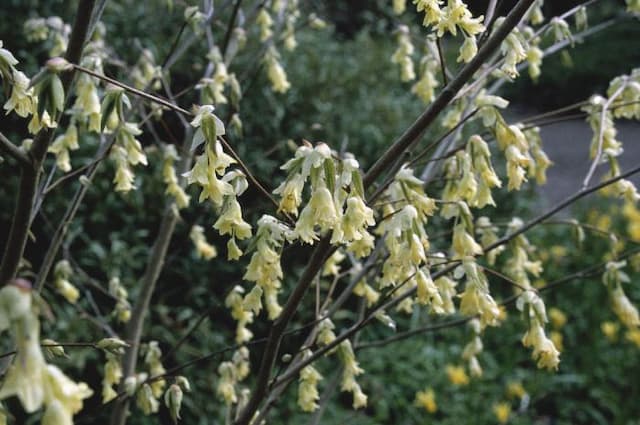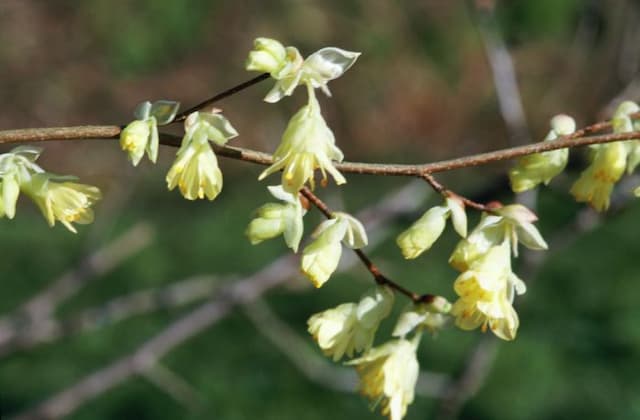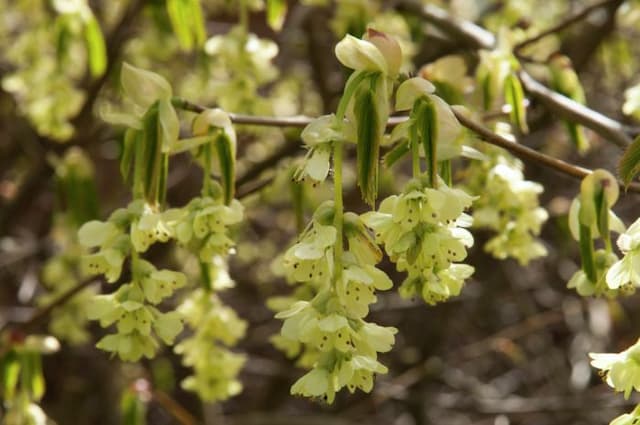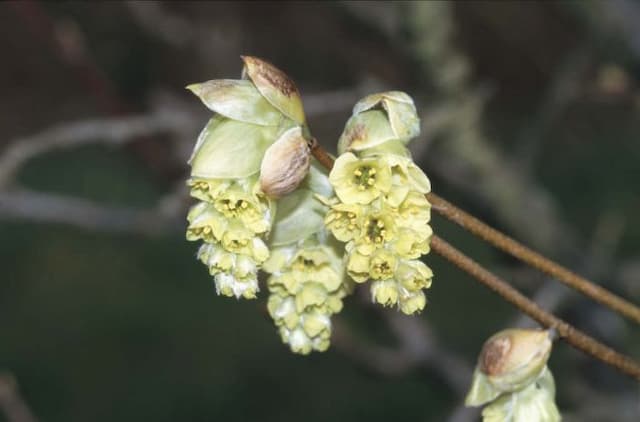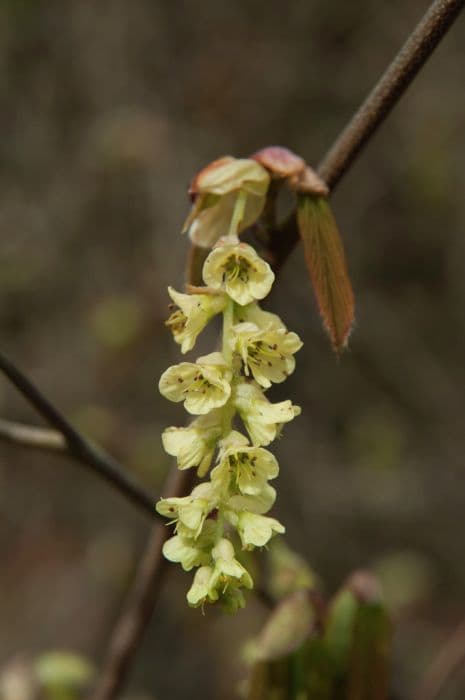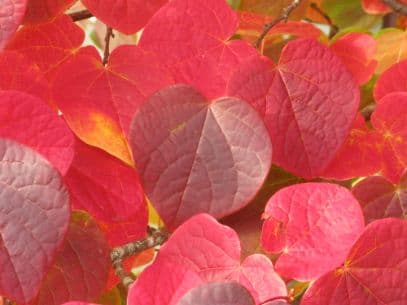Witch Hazel Hamamelis × intermedia 'Nina'

ABOUT
The plant known as Witch Hazel 'Nina' has a distinctive appearance. It is a deciduous shrub that is particularly known for its unique flowers. These flowers are striking, featuring long, ribbon-like petals that are often a vibrant yellow or copper color. They bloom in the late winter to early spring, providing color and interest in the garden at a time when few other plants are in flower. The foliage of Witch Hazel 'Nina' is also attractive, with broad leaves that typically have a rounded or oval shape with a wavy or uneven edge. In the spring and summer, the leaves are a fresh green color, turning to beautiful shades of yellow, orange, or red in the autumn before they fall to the ground. The branches grow in a vase-shaped pattern, spreading out as they mature. This growth habit gives Witch Hazel 'Nina' a somewhat open, airy structure with the flowers standing out clearly against the backdrop of winter skies. The bark of this shrub is smooth to slightly rough in texture and is a grayish-brown color that provides interest in the landscape even when the leaves have fallen. It is also worth mentioning that Witch Hazel 'Nina' is appreciated not only for its ornamental qualities but also for its fragrant flowers, which emit a pleasant scent that can be detected in the air when in bloom. Overall, this Witch Hazel variety is a stunning plant that brings a splash of color and fragrance to gardens during the cooler months of the year.
About this plant
 Names
NamesFamily
Hamamelidaceae.
Synonyms
No common names available.
Common names
Hamamelis × intermedia 'Nina'
 Toxicity
ToxicityTo humans
Witch Hazel 'Nina' is generally considered non-toxic to humans. Ingesting parts of this plant typically does not result in poisoning. Therefore, there aren't any well-documented symptoms of poisoning from consuming Witch Hazel. However, caution should always be exercised as individual reactions can vary, and it is always advisable to avoid eating ornamental plants.
To pets
Witch Hazel 'Nina' is generally recognized as safe for pets, meaning it is not toxic to cats and dogs. There are no specific symptoms of poisoning associated with pets ingesting this plant as it is not known to be poisonous to them. Nonetheless, it is always wise to prevent pets from eating plants not intended for consumption to avoid any possible stomach upset or individual reactions.
 Characteristics
CharacteristicsLife cycle
Perennials
Foliage type
Deciduous
Color of leaves
Green
Flower color
Yellow
Height
8-12 feet (2.4-3.7 meters)
Spread
8-12 feet (2.4-3.7 meters)
Plant type
Shrub
Hardiness zones
5
Native area
Hybrid
Benefits
 General Benefits
General Benefits- Attractive Winter Blooms: Produces vibrant yellow to red flowers in the winter, adding color to otherwise barren landscapes.
- Hardy Plant: Withstands challenging growing conditions and is relatively low-maintenance.
- Wildlife Habitat: Offers shelter and forage for birds and small mammals, particularly in the winter months when resources are scarce.
- Erosion Control: The shrub's dense root system can help stabilize soil and prevent erosion on slopes.
- Seasonal Interest: Provides year-round interest with flowers in winter, lush green foliage in spring and summer, and colorful leaves in fall.
- Architectural Structure: Can be used to create structure in garden design with its strong branching patterns.
- Natural Privacy Screen: When planted in groups or rows, it can form an effective privacy screen or windbreak.
- Aesthetic Versatility: Suitable for a variety of garden styles, including woodland gardens and formal landscapes.
- Drought Tolerance: Once established, it can survive periods of drought with minimal watering.
- Pest and Disease Resistance: Generally resistant to many common pests and diseases, reducing the need for chemical treatments.
 Medical Properties
Medical PropertiesThis plant is not used for medical purposes.
 Air-purifying Qualities
Air-purifying QualitiesThis plant is not specifically known for air purifying qualities.
 Other Uses
Other Uses- Floral Arrangements: The unique, spider-like flowers of the Witch Hazel can provide an exotic touch to floral arrangements, complementing more traditional flowers with its delicate form.
- Winter Garden Interest: Witch Hazel's vibrant yellow to red flowers bloom in late winter, providing color and interest to otherwise barren winter gardens.
- Photography: The distinctive blooms and striking fall foliage offer photographers the chance to capture the beauty of the seasons changing.
- Natural Sunscreen Ingredient: The extracts of Witch Hazel can be used as a component in natural sunscreen formulations due to its potential UV-filtering properties.
- Eco-friendly Insect Repellent: The leaves and bark of Witch Hazel can be used to create a natural insect repellent for garden use.
- Aromatherapy: The distilled Witch Hazel plant, particularly its flowers and leaves, can be used to create essential oils for aromatherapy practices.
- Crafting Dyes: The tannins in Witch Hazel leaves and bark can potentially be used to make natural dyes for textiles and crafts.
- Landscape Design: Witch Hazel can be strategically planted in landscapes to create natural screens or as a focal plant due to its size and shape.
- Soil Erosion Control: The extensive root system of Witch Hazel helps in soil stabilization and erosion control.
- Wildlife Support: Witch Hazel offers nectar to winter-active bees and other pollinators, providing an important food source during scarcer months.
Interesting Facts
 Feng Shui
Feng ShuiThe Witch Hazel is not used in Feng Shui practice.
 Zodiac Sign Compitability
Zodiac Sign CompitabilityThe Witch Hazel is not used in astrology practice.
 Plant Symbolism
Plant Symbolism- Resilience and Survival: The Witch Hazel, to which Hamamelis × intermedia 'Nina' belongs, often blooms in late fall to winter, demonstrating resilience and the ability to thrive in adverse conditions.
- Fragrance and Attraction: As Witch Hazel is known for its fragrant flowers, it symbolizes attraction and the power to draw others in with one's charisma.
- Healing and Protection: Historically, Witch Hazel has been used for medicinal purposes. It symbolizes healing and protection, particularly in spiritual or emotional contexts.
- Uniqueness and Individuality: The unique timing of Witch Hazel's bloom when few other plants flower symbolizes individuality and the courage to stand out.
 Water
WaterThe Witch Hazel 'Nina' prefers consistent moisture, so it's important to water the plant regularly, especially during dry spells. A general rule of thumb is to provide the Witch Hazel with about 1 gallon of water per week, but this can vary depending on climate and soil conditions. Ensure the soil is moist but not waterlogged. During the growing season in spring and summer, you may need to water more frequently; decrease watering in the fall and further in winter when the plant is dormant.
 Light
LightWitch Hazel 'Nina' thrives in full sun to partial shade. It performs best when it receives at least 4 to 6 hours of direct sunlight daily, although it can tolerate less intense light. A spot that offers morning sunlight with some afternoon shade would be ideal to protect it from the harsh late-day sun.
 Temperature
TemperatureWitch Hazel 'Nina' is adaptable to a wide range of temperatures, proving to be quite hardy. The plant can typically survive in temperatures as low as 0°F and as high as 100°F. However, the ideal growing temperatures for Witch Hazel 'Nina' are between 50°F and 70°F.
 Pruning
PruningPruning Witch Hazel 'Nina' is done to maintain shape and encourage healthy growth. The best time to prune is in late winter or early spring, before the new growth begins. Remove any dead or damaged branches, and shape the plant as desired. Pruning once a year is usually sufficient.
 Cleaning
CleaningAs needed
 Soil
SoilWitch Hazel 'Nina' thrives in a well-draining, loamy soil rich in organic matter. The ideal soil mix should consist of two parts garden soil, one part compost or leaf mold, and one part perlite or sand to enhance drainage. The soil pH should be slightly acidic to neutral, ranging from 5.5 to 7.0 for optimal growth.
 Repotting
RepottingWitch Hazel 'Nina' requires repotting every 3 to 5 years to refresh the soil and accommodate root growth. It is best done in late winter or early spring before new growth starts.
 Humidity & Misting
Humidity & MistingWitch Hazel 'Nina' is tolerant of a range of humidity conditions and does well in average outdoor humidity levels. It does not have particular humidity requirements and can thrive in the humidity levels found in most temperate climates.
 Suitable locations
Suitable locationsIndoor
Provide bright, indirect light and cool temperatures.
Outdoor
Plant in part shade; shelter from strong winds.
Hardiness zone
5-8 USDA
 Life cycle
Life cycleHamamelis × intermedia 'Nina', commonly known as Witch Hazel 'Nina', begins its life cycle when a seed germinates, typically in spring after a period of cold stratification. The seedling stage follows, establishing a root system and producing its first leaves. As it grows into a young plant, Witch Hazel 'Nina' develops woody stems and branches, forming a multi-stemmed shrub. During the maturation stage, it blossoms in late winter to early spring with fragrant yellow flowers before the foliage appears. After flowering, it enters a period of vegetative growth where leaves expand and the plant continues to increase in size. The plant reaches reproductive maturity in a few years, producing seeds encased in capsules that, once mature, open to disseminate seeds, and the cycle begins anew.
 Propogation
PropogationPropogation time
Early Spring
The Witch Hazel 'Nina' can be effectively propagated by softwood cuttings. This method usually takes place in late spring or early summer when new growth is still tender but mature enough to handle cutting and rooting. To propagate, a 4 to 6 inch (10 to 15 centimeters) cutting from a healthy branch is taken, ensuring that a few leaves remain at the top. The bottom cut should be made just below a leaf node, where the concentration of growth hormones is higher. The cutting's lower leaves are removed and the base is dipped in rooting hormone to encourage root development. The treated cutting is then planted in a well-draining soil mix, ensuring that the leaf node where the bottom leaves were removed is buried, as this is where the roots will develop. The soil should be kept moist but not waterlogged, and the cutting should be placed in a warm area with indirect light until roots have formed, which could take several weeks. Once the cutting has rooted and shows new growth, it can be transplanted to a more permanent location.
